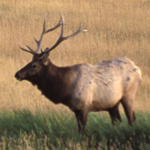|
HOME --> CLASS MAMMALIA
--> ORDER RODENTIA
--> SUBORDER HYSTRICOMORPHA
--> INFRAORDER HYSTRICOGNATHI
--> FAMILY Capromyidae
--> SUBFAMILY Capromyinae
--> GENUS Capromys
SPECIES Capromys pilorides
| Author: | Say, 1822. | | Citation: | Jour. Acad. Nat. Sci. Philadelphia, 2: 333. | | Common Name: | Desmarest’s Hutia | | Type Locality: | "South America or one of the West Indian islands." | | Distribution: | Mainland Cuba, Isle of Youth, Archipiélago de las Doce Lequnas, Archipiélago de Sabana, and many other islands and cays in the Cuban archipelago. | | Status: | IUCN – Lower Risk (lc). Common (extremely abundant in some areas, including Guantanamo Bay Naval Base). | | Comments: | The first mention of this species name is as Mus pilorides Pallas 1778, however, Tate (1935:309) noted that it is not associated with this genus. Sometimes placed in the subgenus Capromys; see Hall (1981:863). This species is very variable in size, coloration, and habits. There are five named subspecies (ciprianoi, doceleguas, gundlachianus, pilorides, and relictus; see Varona (1983a:77) and Borroto Paez et al., 1992:98). No genetic differentiation of cytochrome b was reported for the two subspecies (ciprianoi and relictus) on the Isle of Youth (Woods et al., 2001). However, gundlachianus from Cayo Fragoso was reported to show over 5% sequence divergence and here we are elevating it to species level. Macrocapromys acevedo described by Arredondo (1958:10) is not distinct at the generic level, and is probably synonymous with pilorides. Arredondo's spelling was acevedo, but this was noted as [sic] by Varona (1974) who changed the spelling to acevedoi. This spelling was followed by Hall (1981) but it should be noted that acevado is the correct usage according to Brodkorb (1961). Karyptype has 2n=40; FN=64 (Hsu and Benirschke, 1971; Milišnikov et al., 1990). |
|
| |
|
|



